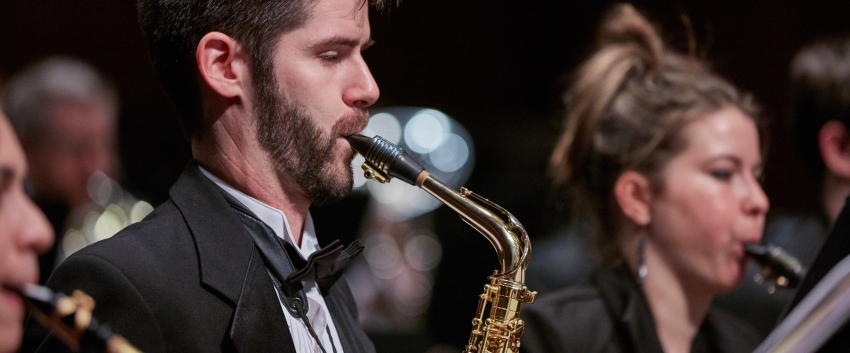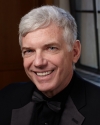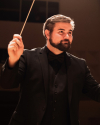The UW Wind Ensemble (Timothy Salzman, director) and Symphonic Band (Shaun Day, director) present their end-of-year concert, performing music by Marie A. Douglas, Jennifer Higdon, Nigel Hess, Paul Dukas, Augusta Read Thomas, and Michael Colgrass. With Carrie Shaw, soprano soloist on Augusta Read Thomas' Of Being is a Bird.
Program
Symphonic Band
Shaun Day, director
Marie A. Douglas (b. 1987): Big City Lights (2021)
Jennifer Higdon (b. 1962): Mysterium
Brandon Cain, conductor
David Maslanka (1943-2017): Give Us This Day (2005)
Short Symphony for Wind Ensemble
I. Moderately Slow
II. Very fast
Wind Ensemble
Timothy Salzman, director
Augusta Read Thomas (b. 1964) : Of Being Is a Bird (Emily Dickinson settings) (2015)
II. Interlude “Flock of Birds”
I. Of Being is a Bird
Carrie Shaw, soprano
Henry Fillmore (1872-1958): Circus Bee (1908)
Corey Jahlas, conductor
Michael Colgrass (1932-2019): Urban Requiem (1995)
Nicholas Franks, soprano saxophone
Ashley Grinstead, alto saxophone
Alexander Yuan, tenor saxophone
Katie Zundel, So., baritone saxophone
Program Notes
Big City Lights is a piece for wind band, inspired by the Hip-Hop sub-genre “Trap Music” which finds its roots in the composer’s hometown, Atlanta, Georgia. The atonal piece has an electronic accompaniment aspect as well. There are musical elements that are meant to imitate techniques which are commonly utilized during the production of music within the genre. For example, in general the timpani performs what are intended to be “808’s”, while the tuba is often performing lines that would be reserved for synthesized bass; the combination creates an often-utilized distortion technique. Other production tactics travel through the ensemble as well. Certain aspects of the orchestration are imitating automation, which places the sound exclusively in different spots of the ensemble (specifically on the left or right of the conductor). Sudden and gradual ensemble crescendos and dovetailing of melodies imitate low and high pass filters and volume knobs. Additionally, the piece aims to give the performers and audience a peek into a day in the life of an Atlanta resident.
This piece begins with the high-paced “It’s Lit!” section which includes fortissimo exclamations occurring throughout the ensemble demonstrating the hustle and bustle of the famed Atlanta traffic. The traffic sounds perform a trio with the clarinets and marimba, who depict a sense of “hurry and wait”, as they endure the Atlanta traffic scene. The “Issa Vibe” section is much slower and intends to depict a night out on the town with friends, enjoying the city light and the slightly slower paced environment. For a short period, we return to “It’s Lit!” followed by “Chopped and Screwed,” which is a halftime recapitulation of the main themes. “Chopped and Screwed” is a famous DJ stule where a song is slowed down tremendously. The piece closes out with on final return to the original marking of “It’s Lit”. Enjoy a day in the life of an “AtLien” with “Big City Lights”!
–Program note by the composer
Mysterium is Jennifer Higdon’s own arrangement of her sacred choral work O Magnum Mysterium for wind ensemble. It was commissioned by Scott Stewart, Emory University Wind Ensemble, and Scott Weiss, University of South Carolina Band. Higdon writes of Mysterium “…is a tribute to the wonderful mystery of how music moves us. Perhaps it is the unexplainable that creates such magic, for both the performer and the listener, but there is no denying the incredible power of a shared musical experience.”
The flute descants and chimes play an important role, creating an antiphonal setting one would traditionally hear in a large cathedral. Higdon’s compositional style utilizes a combination of melody and rhythmic complexity that resemble the text of the original choral setting, which is first heard in Latin and shifts into English. The music is harmonically original, and the colors from every instrument is represented in a very compelling way.
Give Us This Day was commissioned by Eric Weirather, Director of Bands at Rancho Buena Vista High School in Oceanside, Calif., which is in the greater San Diego area. Eric put together a consortium to support the commission. The score was finished in October of 2005, and the premiere performance was done at Eric’s school in the spring of 2006. Since then, with publication of the piece, and a lot of word of mouth, Give Us This Day has literally taken off. It continues to be performed all over the U.S. and many places around the world.
The words “give us this day” are, of course, from the Lord’s Prayer, but the inspiration for this music is Buddhist. I have recently read a book by the Vietnamese Buddhist monk Thich Nhat Hanh (pronounced “Tick Not Hahn”) entitled For a Future to be Possible. His premise is that a future for the planet is only possible if individuals become deeply mindful of themselves, deeply connected to who they really are. While this is not a new idea, and something that is an ongoing struggle for everyone, in my estimation it is *the* issue for world peace. For me, writing music, and working with people to perform music, are two of those points of deep mindfulness. Music allows us to be immediately present, awake, and aware. “Give Us This Day”…Give us this very moment of aware aliveness so that we can build a future in the face of a most dangerous and difficult time.
I chose the subtitle “Short Symphony for Wind Ensemble” because the music really isn’t programmatic in nature. It has a full-blown symphonic character, even though there are only two movements. The music of the slower first movement is deeply searching, while that of the highly energized second movement is at times both joyful and sternly sober. The piece ends with a modal setting of the chorale melody Vater Unser in Himmelreich (“Our Father in Heaven”), #110 from the 371 Four-Part Chorales by J.S. Bach.
–Program note by the composer
Augusta Read Thomas studied composition with Oliver Knussen at Tanglewood, Jacob Druckman at Yale University, with Alan Stout and Bill Karlins at Northwestern University, and at the Royal Academy of Music in London. She was a Junior Fellow in the Society of Fellows at Harvard University and a Bunting Fellow at Radcliffe College — which is now The Radcliffe Institute for Advanced Study at Harvard University — and taught composition at Tanglewood during the summers of 2003, 2004, 2005, 2007, and 2008. Seven years after graduating from the Royal Academy of Music, she was elected an Associate of the Royal Academy of Music (ARAM, honorary degree). In 1998 she received the Distinguished Alumni Association Award from St. Paul's School in Concord, New Hampshire. In 1999, she received the Award of Merit from the President of Northwestern University. At the age of 33, she received tenure from the Eastman School. Ms. Thomas was Composer-in-Residence with the Chicago Symphony Orchestra (1997-2006) and, until 2008, Chair of the Board of the American Music Center, on which she has served for the past five years. Starting September 2006, Thomas resigned from her position as the Wyatt Professor of Music at Northwestern University to devote her time exclusively to composition. Critic Paul Griffith describes Of Being is a Bird:
Augusta Read Thomas has walked a path – or flown – with Emily Dickinson before, in Sunlight Echoes for youth choir and youth orchestra (2002) and Gathering Paradise, a song cycle for soprano and symphony orchestra (2004). This new piece is a pair of bird songs – bird songs that indeed have to do with bird songs, with the songs that birds themselves make, but more, as the title poem indicates, with bird being, with how birds are and also with how birdlike – in flight – being is. After all, the singing here is done by a human being, and by a specific human being, for, the composer tells us, she ‘listened to every recording of Claire Booth I could find and took note of the colour of every pitch in her vocal range.’
Those colours wind through constantly changing textures of instrumental hue in the opening song, where voice and instruments are forever echoing one another, though only the voice, for the most part, has the long line. If any of the instruments is to the fore, it is perhaps the harp, which, to quote the composer, ‘provides a kind of golden thread throughout the piece in counterpoint with the solo soprano’. The harmonies, too, are constantly on the move, adjusting to the vocal line while keeping the music afloat and luminous. We might be hearing the clouds of which the poem speaks, or the easy breeze, or the ‘Wake of Music’, all with a snatch of bird song.
Of Being is a Bird
The likest to the Down
An Easy Breeze do put afloat
The General Heavens — upon —
It soars — and shifts — and whirls —
And measures with the Clouds
In easy — even — dazzling pace —
No different the Birds —
Except a Wake of Music
Accompany their feet —
As did the Down emit a Tune —
For Ecstasy — of it
The Circus Bee March was a celebration of sorts for the fact that Henry Fillmore and his father (who managed their publishing business) finally agreed that the young composer could publish his music “at home” even though it did not meet the elder Fillmore’s standard of being religious music. The title came from an imaginary circus newspaper; if John N. Klohr could name his famous march after a show business paper called The Billboard why not name his new march after a circus paper, real or not? The Circus Bee March reflects Fillmore’s lifelong interest in circuses and his varied experiences while touring with five different big top shows.
— Program Note from Program Notes for Band
Michael Colgrass began his musical career as a percussionist and jazz drummer in Chicago and then New York. In 1978, he won the Pulitzer Prize for Music for Deja vu (the orchestral version) and in 1982 received an Emmy Award for the documentary Soundings: The Music of Michael Colgrass. He also won the Barlow and Sudler Awards for Winds of Nagual, a major work for wind ensemble. Colgrass lived in Toronto, Canada with his wife Ulla, a journalist, and worked as a composer, also doing workshops internationally in performance technique and psychology. He was commissioned by groups including the New York Philharmonic, the Boston Philharmonic, the Toronto Symphony, the National Arts Centre Orchestra, the Canadian Broadcast Corporation, the Lincoln Centre Chamber Music Society and the Brighton Festival in England. Of this evening’s work he wrote:
A requiem is a dedication to the souls of the dead. Urban Requiem might be described as an urban tale, inspired by a diversity of random impressions. I thought of our urban areas, where the saxophone was spawned, and of the tragedies and struggles that occur in this environment daily. But I was also inspired by the energy and power of our cities, and the humor inherent in their conflicts. I feel that the saxophone is particularly well suited to express the variety of emotions required for this idea, because it can be not only highly personal and poignant in character but also powerful and commanding. It can howl like a banshee or purr like a kitten. In short, the saxophone is perhaps more like the human voice than any other instrument. In my mind I heard four saxophones singing like a vocal quartet, a music that was liturgical in nature but with a bluesy overtone, a kind of “after hours” requiem.
|
UNIVERSITY OF WASHINGTON SYMPHONIC BAND FLUTE Callum McCubbin, Sr., Physics, Pullman Tahlia Neely, Fr., Global Literary Studies, Olympia Shelley Shen, Fr., Music, Shanghai China Bethany Quevedo, Jr., ACMS:DSS, Issaquah Jayden Whedbee, Fr., Music, Houston TX Maxwell Williams, Sr., Music Composition and Mathematics, Issaquah OBOE Lauren Majewski, So., Global and Regional Studies, Mercer Island Vichet Ros, Fr., Music Composition, Burien Priyanka Talur, So., Bioengineering, Sammamis BASSOON Ryan Kapsandy, Fr., Bassoon Performance, Olympia Michael Rosen, Fr., BS Chemistry ACS, Data Science Minor, Bellingham CLARINET Aditi Dwivedy, Fr., Psychology/pre-med, Redmond Matilda Gauss, Fr., Engineering Undeclared, Bellevue Karsten Onarheim, Jr., Pre-Sciences, Dillon van Rensburg, Community Member, Edmonds Raul Robles, Jr., Microbiology, Prosser Sagnik Sinha, Fr., Engineering, Redmond Luna Zang, Post Bac, Music Education, Olympia BASS CLARINET Sabrina Barker, Sr., Nursing, Reston VA Aidan Preedy, Sr., Physics and Astronomy, Seattle Ramona Moon, Fr., Environmental Science, Olympia SAXOPHONE Ariana Becker, Fr., Music/Engineering, Bremerton Curtis Chung, Fr., Engineering, Sunnyvale CA Ava Lim, Jr., Human-Centered Design and Engineering, Seattle Julia Macray, Sr., Earth and Space Sciences, Seattle Harlan Molitor, Fr., Undeclared, Saint Paul MN Chinmay Murthy, Fr., Engineering Undeclared, Fremont CA Jack Sawatzky, So., Music Education, Olympia Jony Wang, Fr., Psychology Pre-med, Broomfield CO TRUMPET Felix Chao, Fr., Environmental Science, San Marino CA Riley Huston, Sr., Industrial Design, Kirkland Paige Jenkins, So., Pre-Social Sciences Euan McCubbin, Fr., Undeclared, Pullman John Northey, Music Education, Bellevue Arnav Patnaik, Fr., Psychology/PreMed, Camas Teddy Seligman, Fr., Aeronautical/Astronautical Engineering, San Mateo CA HORN Ellis Haker, Sr., Computer Science, Los Angeles CA Alex Lester, Fr., Undeclared, Pre-med, Davenport IA Alex Morgan, Fr., Engineering, Gig Harbor Noelani Yonahara Stewart, Soph., American Ethnic Studies and Political Science, San Francisco CA Elliana Wagner, Fr., Undeclared, Snohomish TROMBONE Sam Chen, Fr., Engineering Undeclared, Snoqualmie Emily Gay Fr., Music Education, Port Orchard Tom Lewis, Fr., Engineering Undeclared, Snoqualmie Dion Archer-Roll, Soph., Physics, Vancouver Tucker Wilson, Jr., Chemical Engineering, Bothell EUPHONIUM Tyler Fairbanks, Fr., Music Composition, Carlsbad CA John Yi, Soph., Psychology, Bellevue TUBA Foster Patterson, Fr., Music Education, Aberdeen PIANO Richard Li, Fr., Chemistry/Pre-Med, Shanghai China PERCUSSION Aiden Chen, Fr., Undeclared, Belmont CA Amanda O’Brien, Community Member, Psychology, Sammamish Dylan Majewski, Community Member, Civil Engineer, Mercer Island
UNIVERSITY OF WASHINGTON WIND ENSEMBLE FLUTE Grace Jun, Grad., Music Performance, Vancouver* Emily Lee, Grad., Music Performance, Guangzhou, China Elizabeth Nilles, Jr., Biology MCD, Music Minor, Camas Tracia Pan, So., Music Performance, Bellevue Peyton Ray, Fr., Music Performance, Denver, CO Yue Zhong., So., Music Performance, Shanghai, China OBOE Minh Thi Butler, Fr., Music Education, Hoquiam Lexi Doremus-Wessels, Grad., Music Performance, Dubuque, IA* Kamill Tarnawczyk, Sr., Music Performance/Theory, Shoreline BASSOON Nate Chen, Jr., Computer Science, Vancouver Rian Morgan, Fr., Pre-Health Sciences, Des Moines* Griffin Smith, Sr., Philosophy/Music Performance, Fayetteville, AR CONTRABASSOON Griffin Smith, Sr., Philosophy/Music Performance, Fayetteville, AR CLARINET Brady Blaylock, community member, Lindale, TX Mina Hung, Sr., Art & Food Systems, Nutrition, and Health, Taipei Taiwan Alex Gee, So., Mechanical Engineering, Camas* Cameron Lee, Jr., Visual Communication Design and Informatics, Mercer Island Conrad Lin, Jr., Statistics & Economics, Boise, ID Jason Liu, Jr., Mathematics, Camas BASS CLARINET Emerson Bowles, Sr., Physics, San Diego, CA SAXOPHONE Nicholas Franks, Sr., Music Education, Camarillo, CA* Ashley Grinstead, Sr., Chemical Engineering, Seattle Alexander Yuan, Fr., Computer Science, Plainsboro, NJ Katie Zundel, So., Music Performance/Engineering, Clinton TRUMPET Carlos Alvarez, Jr., Informatics, Kirkland Carter Archuleta, Jr., Physics/Astronomy, Gig Harbor Peter Nelson-King, Community Member, Woodinville* Hans Faul, Fr., Music Performance, Seattle Caroline Kelly, Jr., Music Performance/Environmental Science, Chelan Colton Lindstrand, Jr., Biology, Marysville HORN Nicholas Hidy, Grad., Music Performance, Sebastopol, CA Ben Johnson, Grad., Music Performance, Puyallup Sydney Kuhl, Jr., Computer Science, Prior Lake, MN Anna Perry, Grad., Music Performance, Hilliard, OH* Roger Wu Fu, Grad., Wind Conducting, Santiago, Chile TROMBONE Jonathan Elsner, Sr., Mathematics, Kent Peter Lin, Jr., ACMS, Taipei, Taiwan Neal Muppidi, So., Physics/Music, Austin, TX* Duncan Weiner, Jr., Linguistics/ Aeronautical and Astronautical Engineering, Seattle EUPHONIUM Corey Jahlas, Grad., Wind Conducting, Highland, MI* Ethan Walker, Jr., Music Education, Kenmore TUBA Joel Horton, Grad., Music Performance, Lorena, TX* Devin Foster, Grad., Music Performance, Lithopolis, OH BASS Beau Wood, Grad., Music Performance, Longview PERCUSSION Ryan Baker, Jr., Music Composition, Gig Harbor Logan Bellenkes, Jr., Music Performance, Phelan, CA Scott Farkas, Grad., Music Performance, Tacoma* Jack Grenda, Fr., Pre-Social Studies, Encinitas, CA Simon Harty, So., Undeclared, Boise, ID Grace Raichle Rosing, Jr., Mechanical Engineering, Gig Harbor HARP Kelly Guangyin Hou, Jr., Music Performance/Informatics, Bellevue VIOLIN Dalma Ashby, Sr., Music Performance, Seattle Emily Acri, Alumnae, DMA, music performance, Seattle CELLO Ryan Farris, Grd., Orchestral Conducting, Nederland, CO GRADUATE STUDENT CONDUCTORS Shaun Day, Grad., Wind Conducting, Cincinnati, OH Corey Jahlas, Grad., Wind Conducting, Highland, MI Roger Wu Fu, Grad., Wind Conducting, Santiago, Chile *principal |
Biographies
Student Saxophone Quartet
Nicholas Franks, soprano saxophone, is a senior studying music education at the University of Washington School of Music and a Drum Major of the 250-member Husky Marching Band. He is currently completing his student teaching at Islander Middle School and Mercer Island High School. Nick studies the saxophone with Michael Brockman and has been involved with various campus organizations such as Kappa Kappa Psi, Society for Music Educators, UW Stage Notes, and the saxophone studio quartet.
Ashley Grinstead, alto saxophone, is completing her final year at the University of Washington and will graduate with her bachelor’s and departmental honors in Chemical Engineering as well as a minor in mathematics. Her last year has included playing alto saxophone in the UW wind ensemble, working at the boba shop “Don’t Yell at Me”, and doing undergraduate research to engineer fungi’s abilities to break down plastics.
Alexander Yuan, tenor saxophone, is a first-year at the University of Washington from New Jersey and is pursuing a degree in computer science. He originally played alto saxophone and was first chair in both his regional and all state band. He also participated in his high school's jazz and marching bands. He has since transitioned to playing the tenor saxophone after joining the wind ensemble.
Katie Zundel, baritone saxophone, is a second-year honors student at the University of Washington from Whidbey Island. She is pursuing dual degrees in saxophone performance and mathematics. Her accomplishments include winning first prize at the University of Washington Concerto competition in 2023, being awarded the Interdisciplinary Honors Undergraduate Scholar Award in 2021, and being awarded several music scholarships.
Carrie Henneman Shaw joined the Voice Program as an artist in residence in Autumn 2020. As a singer, Carrie engages in a wide variety of musical projects, but she focuses on early and contemporary music. In 2023, she was awarded a Royalty Research Fund grant to research and record experiments in vocal timbre with composer Mauricio Pauly and pianist Mabel Kwan. In 2024, she was awarded the Donald E. Petersen Endowed Faculty Fellowship for Excellence.
A sample of her work includes an upcoming solo recording on Naxos Records of early 18th-century French song; creating music for a live-music-for-dance project with James Sewell Ballet; and collaborating on a recording with the band Deerhoof. Carrie is a two-time winner of a McKnight Fellowship for Performing Musicians, and she is a member of two groups that focus on music by living composers, Ensemble Dal Niente, a mixed chamber collective, and Quince Ensemble, a treble voice quartet.
She appears in numerous recordings ranging from medieval sacred music to a video-game soundtrack, and before coming to the UW, she has been maintaining a full university studio for the six years and participating in educational residencies for composers and performers around the country, including UC-Berkeley, Stanford, New York University, the University of Chicago, and beyond.
Timothy Salzman is in his 38th year at the University of Washington where he serves as Professor of Music/Director of Concert Bands, is conductor of the University Wind Ensemble and teaches students enrolled in the graduate instrumental conducting program. Former graduate wind conducting students of Professor Salzman have obtained positions at 73 universities and colleges throughout the United States and include past presidents of the American Bandmasters Association and the College Band Directors National Association. Prior to his UW appointment he served as Director of Bands at Montana State University where he founded the MSU Wind Ensemble. From 1978 to 1983 he was band director in the Herscher, Illinois, public school system where the band program received regional and national awards in solo/ensemble, concert and marching band competition. Professor Salzman holds degrees from Wheaton (IL) College, and Northern Illinois University, and studied privately with world-renown wind instrument pedagogue Arnold Jacobs former tubist of the Chicago Symphony Orchestra. He has numerous publications for bands with the C. L. Barnhouse, Arranger's Publications, Columbia Pictures, Hal Leonard Publishing and Nihon Pals publishing companies, and has served on the staff of new music reviews for The Instrumentalist magazine. Professor Salzman has been a conductor, adjudicator, arranger, or consultant for bands throughout the United States and in Canada, England, France, Russia, South Korea, Indonesia, Thailand, Singapore, the Philippines, China, and Japan, a country he has visited twenty-one times. Recently he has frequently traveled to China where he served as visiting professor at the China Conservatory, given master classes for numerous wind bands, and conducted several ensembles including the Shanghai Wind Orchestra, the People's Liberation Army Band, the Beijing Wind Orchestra, and the Tsinghua University Band in concerts in 2016/2017/2018. He also served on three occasions as an adjudicator for the Singapore Youth Festival National Concert Band Championships. He has also conducted several of the major military bands in the United States including a 2019 world premiere with 'The President's Own' United States Marine Band. He is compiling editor and co-author (with several current and former UW graduate students) of A Composer's Insight: Thoughts, Analysis and Commentary on Contemporary Masterpieces for Wind Band, a five-volume series of books on contemporary wind band composers. He is a contributing author to a new book (2022) about his former teacher Arnold Jacobs: His Artistic and Pedagogical Legacies in the 21st Century. He is also an elected member of the American Bandmasters Association and is a past president of the Northwest Division of the College Band Directors National Association.
As a conductor, trumpet player, and educator, Shaun Day enjoys sharing his passion by working with a variety of music ensembles and creating a positive community through music. Shaun is completing his DMA in Instrumental Conducting at the University of Washington where he is the director and conductor for the UW Symphonic Band, and the associate conductor for the UW Wind Ensemble. He is also serving as the Conductor and Artistic Director for the Mukilteo Community Orchestra and enjoys connecting with local music educators in the Seattle area. Shaun continues to work as an ensemble clinician, guest conductor, and as a presenter at music education conferences, including the Washington Music Educators Association (WMEA) State Conference.
Originally from Cincinnati, Ohio, Shaun earned his BM in Music Education with a concentration in trumpet performance, and his MM in Conducting from the University of Cincinnati, College-Conservatory of Music (CCM). During that time, he was the manager of the CCM Wind Symphony, CCM Brass Choir, the University Commencement Band, and a Graduate Assistant of the University of Cincinnati Bearcat Band. Shaun also served as the Associate Conductor of the University of Cincinnati Symphony Orchestra and Guest Conductor for the Fillmore Philharmonic Brass (OH).
Before completing his MM, Shaun was the assistant band director at Turpin High School in Cincinnati. His duties included directing the high school concert bands, directing the high school jazz program, the musical theatre pit orchestra, assisting and directing the high school marching band program, and directing the 5th-12th concert bands. His professional affiliations include the College Band Directors National Association (CBDNA), Washington Music Educators Association (WMEA), and the Ohio Music Education Association (OMEA) where he served as the District XIV Secretary and Treasurer from 2016-2018.
Originally from Highland, MI, Corey Jahlas is in his first year of the Doctor of Musical Arts and Instrumental Conducting program at the University of Washington, where he serves as a Graduate Student Conductor of the Husky Athletic Bands, co-conductor of the Campus Band, and assistant conductor of the Wind Ensemble.
Most recently, Corey earned his Master of Music in Wind Conducting from Central Michigan University, studying with Prof. Jack Williamson. There, he instructed the 280-member Chippewa Marching Band and served as the instructor on record for the Symphony Band and the University Band. Prior to his Master’s work, Corey taught from 2014-2017 in Oxford, MI, leading the middle school band program, the OMS Percussion Ensemble, and assisting with the OHS Wildcat Marching Band.
Corey also holds degrees in Music Education and Music Theory and Composition from Central Michigan, where he studied euphonium with Dr. Mark Cox and composition with Dr. David Gillingham. Sharing his love for the marching arts, Corey served as Assistant Director of the Madison Scouts Drum and Bugle Corps in 2014, having marched with the group in 2011. He also serves as a clinician, arranger, and drill writer for high schools and university marching bands in Michigan, Ohio, Pennsylvania, and New Hampshire, and is the Director of the Drum Major Camp at Central Michigan University. Corey holds memberships in the National Association for Music Education, Pi Kappa Lambda, Phi Mu Alpha Sinfonia, and Kappa Kappa Psi.




